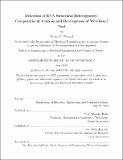Detection of RNA structural heterogeneity : computational analysis and development of web-based tool
Author(s)
Persad, Sitara C
DownloadFull printable version (5.067Mb)
Alternative title
Detection of ribonucleic acid structural heterogeneity : computational analysis and development of web-based tool
Other Contributors
Massachusetts Institute of Technology. Department of Electrical Engineering and Computer Science.
Advisor
Manolis Kellis and Silvia Rouskin.
Terms of use
Metadata
Show full item recordAbstract
Beyond its function as a messenger molecule in protein formation, the linear sequence on RNA is capable of folding into higher order structures which may interact with other molecules and play key functional roles in the cell. Current methods in characterizing RNA structure via experimental probing are limited to the population average, which obscures structural heterogeneity. This thesis addresses the problem of inferring structural heterogeneity from dimethyl sulphate (DMS) probing data. First, we analysed sequence data to uncover experimental biases and developed simulations for sample structures. We proposed and evaluated machine learning methods in unsupervised learning to infer structural heterogeneity. Secondly, we designed and implemented runDMC, a web platform designed to facilitate the discovery of alternative RNA secondary structures, using in vivo chemical probing data and machine learning clustering methods. runDMC accepts experimental probing data and provides an intuitive, user-friendly interface for discovery of alternative structures. We anticipate that runDMC will facilitate the widespread use of DMS probing and analysis in the biological community, enabling the discovery of more RNA alternative structures.
Description
Thesis: M. Eng., Massachusetts Institute of Technology, Department of Electrical Engineering and Computer Science, 2018. This electronic version was submitted by the student author. The certified thesis is available in the Institute Archives and Special Collections. Cataloged from student-submitted PDF version of thesis. Includes bibliographical references (pages 77-78).
Date issued
2018Department
Massachusetts Institute of Technology. Department of Electrical Engineering and Computer SciencePublisher
Massachusetts Institute of Technology
Keywords
Electrical Engineering and Computer Science.